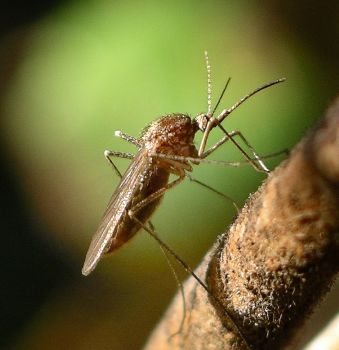
Culiseta inornata
Mosquitoes, or mossies, as my Australian pen pal calls them, have been in the news lately due to yet another disease they spread: Zika virus. This particular pathogen was first noticed in Africa, but is now widespread. It joins other mosquito-borne viruses such as Chikungunya, Eastern Equine Encephalitis, and West Nile in being a major health issue. Mosquitoes are also vectors of parasites, including Malaria and Dog Heartworm. Not all species of mosquitoes carry all diseases, but there are a number of different species. Certain genera are associated with spreading specific pathogens. Some examples include: Malaria - Anopheles, Dengue and Zika - Aedes, and Eastern Equine Encephalitis - Culex and Culiseta. Discussing an animal that spreads serious diseases often elicits reactions that are more emotional than rational, but there are many informational sources for all the health-related issues associated with such a medically significant insect.
 Culiseta inornata |
Lumping all mosquitoes into one category is a little like saying all felines are alike. It's obvious that a lynx, tiger, and domestic cat are all different species. Although all mosquitoes are in the same family (culicidae), there are a number of different genera and species as well. Most mosquitoes fly during dawn and dusk, but some are active mainly during the day or at night. Some mosquito species lay their eggs in ponds or large water tanks. Others prefer tiny cuplike cavities, such as holes in trees or the bases of flower pots. Only the females of certain species seek out a blood meal, which allows their eggs to develop. The females also sip nectar from flowers, and that is the entire diet of males, which do not have the modified mouthparts necessary to pierce skin.
It might come as a surprise that mosquitoes are actually flies. They possess only one pair of wings and are in the order Diptera, along with gnats, house flies, and midges. Crane flies, which are very numerous in the spring, are also related. In fact, they look a whole lot like humungous mosquitoes, but they never bite humans. Whew!
Like all other flies, mosquitoes develop through complete metamorphosis. After the eggs hatch, the aquatic larvae of most species filter feed. They hang from the surface of the water, with a rear end tube for breathing. As the larvae grow, they molt several times, eventually reaching the pupa stage. The pupa can still wiggle its "tail" but it doesn't feed. The adult emerges from a split in the pupal skin and rises out of the water. In a very short time, its wings dry, and it can fly away.
The largest species of mosquito found in central Texas is the appropriately named Elephant Mosquito (Toxorhynchites rutilus). It is alarmingly big, but we have nothing to fear - it does not feed on blood, only nectar. The best part, though, is that the larvae of the Elephant Mosquito eat other mosquito larvae. They are so efficient at wiping out their kin that they tend to be very rare. Once they eat all the other mosquitoes in their habitat, they turn on each other, so only a few survive to adulthood. Such aggressive predators eliminate their food supply if they become too numerous. So much for a great natural pest control idea.
Though mosquitoes spread so many diseases and are the bane of humans and their domestic animals, these insects fill quite a large niche in the food web. Fish and predatory water insects feast on the larvae, as do filter-feeding ducks such as the Northern Shoveler. The Muscovy Duck is considered to be an excellent mosquito eater. Once the mosquitoes take wing, they are food for other insects, bats, and birds. The tiny damselflies that often hover around our feet as we walk near streams are superb mosquito hunters. Humans can use common sense when it comes to controlling mosquitoes in general: eliminate standing water, use screens on windows, and avoid being outside when the mossies are most active. The best defense is to wear long sleeves, long pants, and hats, but don't forget to use DEET!